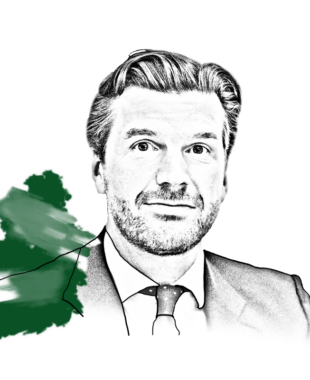The extraction of oil and gas from shale rock formations, more commonly known as ‘fracking’ has transformed the US energy market. The implications for the delicate balance of energy supply and demand around the world, with its geo-political significance, have been profound. Just as profound have been the legitimate concerns and claims around the environmental impact of this extraction process. Investment Manager, Des Armstrong joined the management of EOG Resources on their inaugural ESG tour.
Few issues energise environmental campaigners more than fracking. The process of hydraulic fracturing of shale reserves has been linked to a myriad of environmental transgressions, most notably around its geological impact, pollution and water wastage. The result has been intense regulatory scrutiny and prohibitions in a number of countries.
Despite some restrictions at a state level, the US has been far more open to fracking than many. This more supportive environment helped drive the US shale ‘revolution’, transforming the country’s production of oil and natural gas.
I’ve long sensed that EOG was doing more from an environmental perspective than it was communicating
EOG Resources is widely recognised as one of the founders of this revolution. Focused primarily on reserves in Texas and New Mexico, the company is a leader in North American exploration. This reputation has been earned through its success in harnessing technology to better interpret geological data and improve understanding of new drilling techniques and well stimulation. Since the early 90s, we’ve watched as its innovative approach has delivered a deep inventory of excellent quality, low-cost reserves and best-in-class well-completion capabilities.
That said, one area where EOG has been accused of being a little late to the party is ESG (Environmental, Social and Governance) or at least in addressing the ‘E’ element of its operations. I’ve long sensed that EOG was doing more from an environmental perspective than it was communicating, so an invitation to attend the company’s first ESG-focused field trip was a fantastic opportunity to get a first-hand view of some of the work it’s been doing in this area.
The two day trip centred on EOG’s operations in the vast Permian Basin of West Texas and Southeast New Mexico.
The first day involved getting out into the oil patch. Starting early in the morning in Midland, Texas, we travelled to the north of the Delaware basin to North Red Hills. Our route took us to the deepest section of one of the Permian’s three sub-basins. The Wolfcamp level lies below the Delaware basin at a depth of approximately 12,000 feet. Here, the company outlined its use of technology to limit the environmental impact of pulling oil and gas out of a two million-year-old shale formation.
Donning hard hats, we were given a comprehensive walkthrough of the company’s operations. I shall admit to some trepidation as we climbed a working rig. But chatting to the oilmen, and listening as they talked through control dashboards and all the processes, checks and data gathering represented, was invaluable. This ‘well to wheels’ walkthrough gave incredibly useful context for the more formal presentations to come on the second day.
One example of how EOG is working to reduce diesel consumption is through the adoption of e-frac technology
EOG’s operations can be split into three distinct stages: drilling; completion & production; and gathering & processing. Each of these is subject to environmental stress points. How EOG is dealing with these stress points illustrates exactly why it has a reputation as an industry innovator.
Take the combustion of diesel, which is responsible for a sizeable portion of EOG’s greenhouse gas emissions. One example of how the company is working to reduce diesel consumption is through the adoption of e-frac technology, which uses natural gas, rather than diesel, to power its pressure pumping equipment. The resultant reduction in emissions is estimated to be in the region of 40%.
The benefits don’t stop at the environmental level. The move to e-frac also makes good business sense. Through savings on diesel costs and because natural gas is a by-product of the extraction process, EOG told me that this technology can save around US$200,000 per well.
I was also struck by the progress EOG has made on water re-use. The amount of water involved in fracking is huge, which has long been a criticism levelled at the industry. Not only is freshwater needed during the fracturing process, but contaminated wastewater, known as produced water, then rises to the surface. Typically, US shale producers have injected this wastewater into deep disposal wells, but EOG is now making significant strides in recycling its produced water. In the Delaware Basin, reuse now stands at 90% compared to 60% in 2018. Freshwater use is down to 9%.
By reducing water costs, the company has made material savings in operating expenses and capital expenditure
This has been driven by a number of factors but key has been the extensive infrastructure investment. EOG now has over 500 miles of produced water gathering pipeline, nine one-million barrel water reuse pits, five treatment facilities and 27 miles of water reuse distribution pipeline. The site I visited processes between 70,000 to 120,000 barrels of water per day into the reuse pit. I was also able to observe the company’s impressive proprietary water management system in action. The system, named Trident, allows ‘real-time’ modelling of water distribution. This gives EOG the ability to optimise its water transportation needs.
EOG’s approach to the use of water is another example of where adopting sound ESG practices makes financial sense. One of the business’s largest operating expenses is water. By reducing water costs, the company has made material savings in operating expenses and capital expenditure.
Other highlights for me included a pilot solar and natural gas scheme to replace the diesel powered generators it uses to deliver the necessary compression to distribute vast quantities of its products across its piped infrastructure. Elsewhere, fugitive gas emissions have been reduced by 90% with the rollout of its LDAR (Leak Detection and Repair) programme, which involves the inspection of over nine million components. Next stop, a pilot drone LDAR programme; for EOG, innovation is a constant.
This commitment to investing in innovative technology to drive efficiencies, and in turn improve a number of its environmental outcomes, really was one of the standout takeaways from my time with EOG. The quantity of real-time data the company has access to, and how it uses this to monitor and optimise its operations, genuinely differentiates the company. Indeed, you could say that EOG is becoming a technology company that just happens to pull stuff up from the ground.
If I were to criticise the event, it was the lack of discussion concerning the elephant in the room, EOG’s scope 3 emissions. Even if EOG’s direct emissions trend to zero, the company’s net carbon footprint will still increase through the continued growth in its production that today represents approximately 85% of EOG’s total GHG emissions.
What really shone through was the alignment of EOG’s corporate strategy with its sustainability goals
EOG has stated in the past that it has no intention of developing a decarbonisation strategy outside its direct operations. Indeed the company has formally published scenario analysis that stress tests its existing portfolio assuming oil demand is considerably worse than that implied by the Paris Agreement. They have included a $140/tonne carbon cost into that work and concluded that even with no further improvement in the operational performance of EOG’s business, the company still generates meaningful net present value through to 2040. That said, it does seem reasonable to expect more constructive environmental steps, particularly given the many emerging technologies in carbon capture.
Over the two days, I spent a lot of time speaking with EOG’s senior management as well as more junior but equally impressive talent. This in itself was interesting and conveyed the trust that management have in the team around them and the responsibility they’re willing to bestow on the next generation.
What really shone through was the alignment of EOG’s corporate strategy, and its emphasis on culture, data, technology and returns, with its sustainability goals. All of the company’s ESG initiatives have been enabled by its business strategy rather than being developed merely to create an impression of being ‘good.’
Not only are the building blocks of a comprehensive ESG strategy firmly in place, but collectively those blocks have the potential to reduce EOG’s direct environmental footprint to a meaningfully low level. EOG’s implicit aspiration to become one of the world’s most environmentally operationally efficient companies, not just within oil and gas, is to be applauded. The company’s roadmap to deliver this is credible and is being aggressively pursued by its management team.
As a complement to the in-depth, desk-based research we carry out back home in Edinburgh, this latest trip to Texas reaffirmed my confidence in the company, its management and its culture. EOG has a very positive story to tell.
Important Information
This article is provided for general information only and should not be construed as investment advice or a recommendation. This information does not represent and must not be construed as an offer or a solicitation of an offer to buy or sell securities, commodities and/or any other financial instruments or products. This document may not be used for the purpose of an offer or solicitation in any jurisdiction or in any circumstances in which such an offer or solicitation is unlawful or not authorised.
Stock Examples
The information provided in this article relating to stock examples should not be considered a recommendation to buy or sell any particular security. Any examples discussed are given in the context of the theme being explored.


